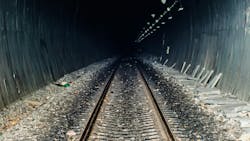Are Railroads Slowly Committing Suicide?
Commentary/Analysis
North America’s remaining six major freight railroads appear to be committing slow motion suicide, according to testimony offered by rail customers, industry analysts and labor to regulators on the Surface Transportation Board (STB) at two days of public hearings held last month.
STB Chairman Robert E. Primus contended that the industry’s growth has not measured up to all of the opportunities that were presented to it over the past seven years, after Wall Street activist investors ignited the fad of Precision Scheduled Railroading (PSR), an operations model sold to investors as a Holy Grail by prioritizing squeezing out costs over growing the business, and which has persisted since gaining widespread acceptance among investors in 2017.
In the 19th Century the railroads created a foundation for the growth of America’s modern industrial economy. But today shippers are turning to trucking to serve their freight transportation needs every chance they get so they can avoid subjecting themselves to the unreliable service and rate gouging dealt out by rail lines. As a result, even in economic good times, railroad traffic has not kept up with the growth of the rest of the economy, the manufacturing industry, exports and imports and its main competitor—trucking.
Both Primus and shipper witnesses pointed out that intermodal service, once widely recognized as the future of the railroad industry, has declined along with the steady decline in service reliability, and the result has driven freight onto the highways, which also drives up logistics costs while contributing even more to air pollution.
“If you’re not reliable and you can’t provide service and you’re not competitive, you’re not going to have growth,” argued Mike Seyfert, CEO of the National Feed and Grain Association, at the STB hearing.
The Wall Street hedge fund managers who bet heavily on PSR embraced a scheme to sell investors on securing the lowest possible Operating Ratio (OR), a simplistic and crude measurement calculated by dividing a company's total operating costs by its net sales. “The lower the OR, the more attractive the company to invest in” was the theory then and still is today.
To obtain that lower OR, PSR called for closing railyards, mothballing operating equipment and laying off tens of thousands of employees. In recent years we have learned that those layoffs put such pressure on the remaining employees that many of them quit or retired rather than continue to be overworked. Threatened labor action last year resulted in major railroads agreeing to allowing more leave—especially sick leave—for employees.
Major railroads also promised to hire and train new employees, but they soon ran into an unusual problem. When the new recruits for these highly paid positions learned about the schedules they would be expected to work, they walked away from the jobs.
Union officials appearing before the September STB hearing also said much of the rolling stock that had been mothballed had been cannibalized to repair the equipment still working, stolen or corroded beyond usefulness.
Most of the rail executives testifying before the board seemed to be reporting from a different world than everyone else has been living in for the past seven years, boasting about capital investments and service improvements that appeared to be largely illusory, if the rail customers are to be believed. The difference was so stark that Vice Chair Karen Hedlund went so far as to call it “a tale of two cities”—a view seconded by Primus.
Although rail customers concede that there have been some improvements in recent years on some of the major rail lines, those they are willing to credit are said to be small and have made a little difference in the overall levels of service. In addition, rapacious practices designed to run up demurrage fees for late return of cars continue. The STB may have encouraged better and more frequent reporting and communications over delivery scheduling, but those improvements have been spotty as well.
Rail System in Decline
The Federal Reserve of St. Louis reported there has been a steady decline in railroad traffic over the past two decades, including a 28% drop over the most recent 10-year period. But at the same time that happened, railroad shipment rates came close to doubling.
Testifying for the Alliance for Chemical Distribution, Richard Erstad, vice president and general counsel for Hawkins Inc., observed that the explanation for the decline in rail traffic is simple. “The deteriorating rail service members have experienced for decades makes it exceedingly difficult for shippers to do business with railroads as they are at risk of losing customers if they cannot provide them with reliable shipments,” he said.
Byron Porter, CEO of Hum Industrial Technology, told the board, “What is notable is that with each downturn in freight volumes, the freight that did come back shifted from rail to truck. When shippers who had the luxury to pick modes were given the chance to reevaluate their supply chains, they specifically chose trucks.”
Daniel Elliott, an attorney with GKG Law, testifying on behalf of the Private Railcar Food and Beverage Association, added, “This reduction in capacity and service by the railroads forced many shippers to increase the volume they shipped over the road. Over the period of the last five or six years, truck volume has increased while rail volume has continued to decline.”
He pointed out that while the railroads claim their services have improved—and in some cases they have marginally—this has occurred “because they eliminated volume, hence congestion, hence the need for employees and equipment, but still with higher rates to their remaining shippers.”
What is particularly frustrating for shippers is that little has really improved in spite of all of the congressional and STB hearings held in recent years, and even after PSR played a role in a nationwide labor action that threatened to shut down rail service late last year. Even after the board ordered Class 1 railroads to submit regular service metric reports, the companies dragged their feet and substantial service improvements failed to materialize.
Also failing to lead to improved service was the board’s decision to adopt a longstanding shippers’ proposal to allow reciprocal shipping, where railroads can move their own cars over another railroad’s tracks. In fact, after years of seeking this change, shippers informed the board earlier this year this has been an abject failure and needs to be revised.
The main problem is that the switching rule specifically excludes any rail traffic that moves under contract, preventing the vast majority of rail customers from accessing competitive rail service, chemical shippers pointed out to the board last May.
At the September hearing, Jeffrey Sloan, senior director of regulatory and scientific affairs at the American Chemistry Council (ACC), urged the board to create an improved version of reciprocal switching to promote rail-to-rail competition.
“Broadly implemented, reciprocal switching can help unlock market forces and incentivize railroads to provide reasonable rates and adequate service,” he explained. “This will drive more business to the railroads, with benefits to the nation’s economy, consumer prices and climate goals.”
But in the end, the board needs to find a way to wrestle with the ravages wrought by PSR, Sloan stressed. “ACC members have dealt with a lengthy list of significant challenges over the years. Key among them are excessive rates and charges, unreliable service, and a lack of network resiliency. These ongoing problems have made rail a difficult and less viable mode of transportation and risk driving shippers to pursue alternatives.”
What can be done to improve the current situation while laying the groundwork for creating an operating environment in which railroads can grow volumes profitably to thrive and serve the nation’s transportation needs?
A few years ago, this writer suggested that because the STB apparently had reached the limits of its power to improve things, it might be time for Congress to consider a public utility approach to rail regulation, given the lack of competition in the industry and failure of Wall Street investors to act in the public interest. My idea was shot down by no less than former Rep. Peter DeFazio (D-Ore.), chair of the congressional Transportation and Infrastructure Committee, when he introduced another two-day public hearing on railroad misfeasance.
So, what ultimately is the answer? At this point, no one seems to know.
About the Author

David Sparkman
founding editor
David Sparkman is founding editor of ACWI Advance (www.acwi.org), the newsletter of the American Chain of Warehouses Inc. He also heads David Sparkman Consulting, a Washington D.C. area public relations and communications firm. Prior to these he was director of industry relations for the International Warehouse Logistics Association. Sparkman has also been a freelance writer, specializing in logistics and freight transportation. He has served as vice president of communications for the American Moving and Storage Association, director of communications for the National Private Truck Council, and for two decades with American Trucking Associations on its weekly newspaper, Transport Topics.
